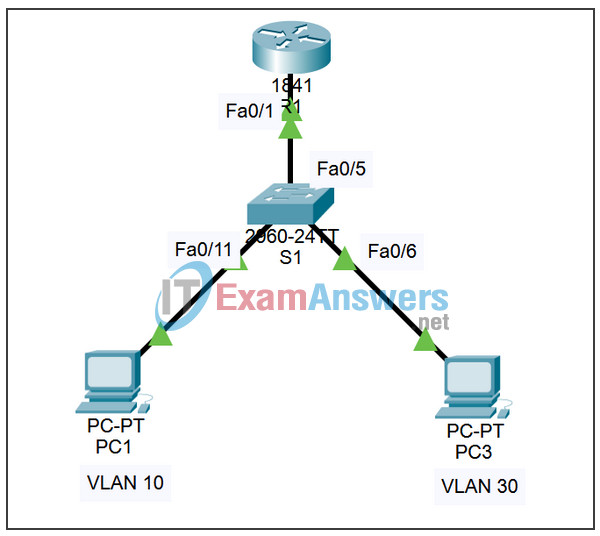6.3.3 Packet Tracer – Troubleshooting Inter-VLAN Routing Answers
Topology

Addressing Table
| Device | Interface | IP Address | Subnet Mask | Default Gateway |
|---|---|---|---|---|
| R1 | Fa0/1.10 | 172.17.10.1 | 255.255.255.0 | N/A |
| Fa0/1.30 | 172.17.30.1 | 255.255.255.0 | N/A | |
| PC1 | NIC | 172.17.10.10 | 255.255.255.0 | 172.17.10.1 |
| PC2 | NIC | 172.17.30.10 | 255.255.255.0 | 172.17.30.1 |
Learning Objectives
- Test connectivity between PCs and a router
- Gather data on the problem
- Implement the solution and test connectivity
Introduction
In this activity, you will troubleshoot connectivity problems between PC1 and PC3. The activity is complete when you achieve 100% and the two PCs can ping each other. Any solution you implement must conform to the topology diagram.
Task 1: Test Connectivity between PCs and a Router
Use the Add Simple PDU tool to ping between two PCs on the same VLAN. The following tests should be successful at the conclusion of this activity:
- PC1 can ping R1
- PC3 can ping R1
- PC1 can ping PC3
Each of these tests should fail on the first attempt.
Task 2: Gather Data on the Problem
Step 1. Verify the configuration on the PCs.
Are the following configurations for each PC correct?
- IP address
- Subnet mask
- Default gateway
Step 2. Verify the configuration on S1
Are the configurations on the switch correct? Be sure to verify the following:
- Ports assigned to the correct VLANs
- Ports configured for the correct mode
- Ports connected to the correct device
Step 3. Verify the configuration on R1.
Are the configurations on the router correct? Be sure to verify the following:
- IP addresses
- Interface status
- Encapsulation and VLAN assignment
Step 4. Document the problem and suggest solutions.
What are the reasons why connectivity failed between the PCs? What are the solutions? There could be more than one problem and more than one solution. All solutions must conform to the topology diagram.
What is the problem, if any, and the solution for the PCs?
What is the problem, if any, and the solution for S1?
What is the problem, if any, and the solution for R1?
Task 3: Implement the Solution and Test Connectivity
Step 1. Make changes according to the suggested solutions in Task 2.
Note: If you make changes to the switch configuration, you should make the changes in Realtime mode rather than Simulation mode. This is necessary so that the switch port will proceed to the forwarding state.
Step 2. Test connectivity between PCs and R1.
If you change any IP configurations, you should create new pings because the prior pings use the old IP address.
- PC1 should be able to ping R1.
- PC3 should be able to ping R1.
- PC1 should be able to ping PC3.
If any pings fail, return to Task 2 to continue troubleshooting.
Step 2. Check results.
Your completion percentage should be 100%. If not, return to Step 1 and continue to implement your suggested solutions. You will not be able to click Check Results and see which required components are not yet completed.
